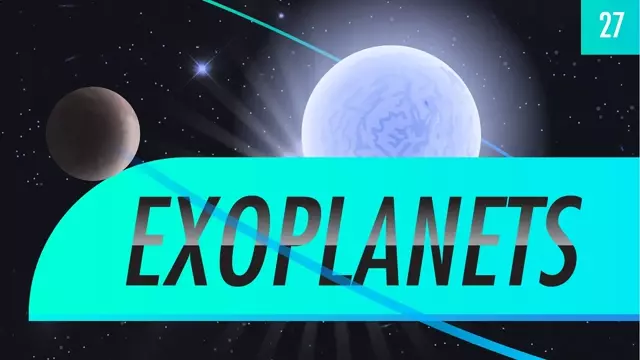2015-08-06
[public] 1.19M views, 17.7K likes, 224 dislikes audio only
Today Phil explains that YES, there are other planets out there and astronomers have a lot of methods for detecting them. Nearly 2000 have been found so far. The most successful method is using transits, where a planet physically passes in front of its parent star, producing a measurable dip in the star’s light. Another is measuring the Doppler shift in a star’s light due to reflexive motion as the planet orbits. Exoplanets appear to orbit nearly every kind of star, and we’ve even found planets that are the same size as Earth. We think there may be many billions of Earth-like planets in our galaxy.
For more information on reflexive motion, you can check out Phil's blog: http://www.slate.com/blogs/bad_astronomy/2015/08/07/crash_course_astronomy_exoplanets.html
Check out the Crash Course Astronomy solar system poster here: http://store.dftba.com/products/crashcourse-astronomy-poster
--
Chapters:
Introduction: Exoplanets 00:00
Reflexive Motion 1:29
Discovering the First Exoplanets 2:07
51 Pegasi b 3:08
Exoplanets in Transit 5:42
Detecting Exoplanet Transits 6:32
Photographing Exoplanets 7:12
Kinds of Exoplanets 8:18
Earth-like Exoplanets 9:33
Review 10:48
--
PBS Digital Studios: http://youtube.com/pbsdigitalstudios
Follow Phil on Twitter: https://twitter.com/badastronomer
Want to find Crash Course elsewhere on the internet?
Facebook - http://www.facebook.com/YouTubeCrashCourse
Twitter - http://www.twitter.com/TheCrashCourse
Tumblr - http://thecrashcourse.tumblr.com
Support CrashCourse on Patreon: http://www.patreon.com/crashcourse
--
PHOTOS/VIDEOS
Stars as viewed from ISS https://www.youtube.com/watch?v=TOQrx-7qgak [credit: Alex Rivest & NASA]
Jupiter http://www.nasa.gov/centers/goddard/multimedia/largest/Jupiter_sphere.jpg.html [credit: NASA]
Mars http://mars.jpl.nasa.gov/multimedia/images/?ImageID=2633 [credit: NASA/JPL-Caltech/MSSS]
Mercury http://solarsystem.nasa.gov/multimedia/display.cfm?Category=Planets&IM_ID=7543 [credit: NASA/Johns Hopkins University Applied Physics Laboratory/Carnegie Institution of Washington]
Earth https://www.nasa.gov/topics/earth/overview/index.html [credit: NASA]
Uranus http://photojournal.jpl.nasa.gov/catalog/PIA18182 [credit: NASA/JPL-Caltech]
Lost in the Glare http://planetquest.jpl.nasa.gov/video/23 [credit: NASA Kepler Mission/Dana Berry]
Reflexive Motion gifs http://spaceplace.nasa.gov/barycenter/en/ [credit: NASA]
Artist's conception of PSR B1257+12's system of planets https://en.wikipedia.org/wiki/Pulsar_planet#/media/File:Artist%27s_concept_of_PSR_B1257%2B12_system.jpg [credit: NASA/JPL-Caltech/R. Hurt (SSC)]
Artist’s impression of the exoplanet 51 Pegasi b (image) http://www.eso.org/public/usa/images/eso1517a/ [credit: ESO/M. Kornmesser/Nick Risinger (skysurvey.org)]
Artist’s impression of the exoplanet 51 Pegasi b (video) http://www.eso.org/public/usa/videos/eso1517b/ [credit: ESO/M. Kornmesser/Nick Risinger (skysurvey.org)]
Kepler Transit Graph http://planetquest.jpl.nasa.gov/video/22 [credit NASA Kepler Mission/Dana Berry]
Kepler “Beauty Shot” http://planetquest.jpl.nasa.gov/video/2 [credit: NASA/Kepler mission/Dana Berry]
The Brown Dwarf 2M1207 and its Planetary Companion https://www.eso.org/public/usa/images/eso0515a/ [credit: ESO]
Beta Pictoris b http://www.eso.org/public/archives/images/screen/eso1024c.jpg [credit: ESO]
A size comparison of the planets in the Kepler-37 system and objects in the Solar System http://photojournal.jpl.nasa.gov/catalog/PIA16694 [credit: NASA/Ames/JPL-Caltech]
Water World http://planetquest.jpl.nasa.gov/video/39 [credit: NASA Kepler Mission/Dana Berry]
Earth-like World http://planetquest.jpl.nasa.gov/video/42 [credit: NASA Kepler Mission/Dana Berry]
/youtube/video/7ATtD8x7vV0?t=0
/youtube/video/7ATtD8x7vV0?t=89
/youtube/video/7ATtD8x7vV0?t=127
/youtube/video/7ATtD8x7vV0?t=188
/youtube/video/7ATtD8x7vV0?t=342
/youtube/video/7ATtD8x7vV0?t=392
/youtube/video/7ATtD8x7vV0?t=432
/youtube/video/7ATtD8x7vV0?t=498
/youtube/video/7ATtD8x7vV0?t=573

